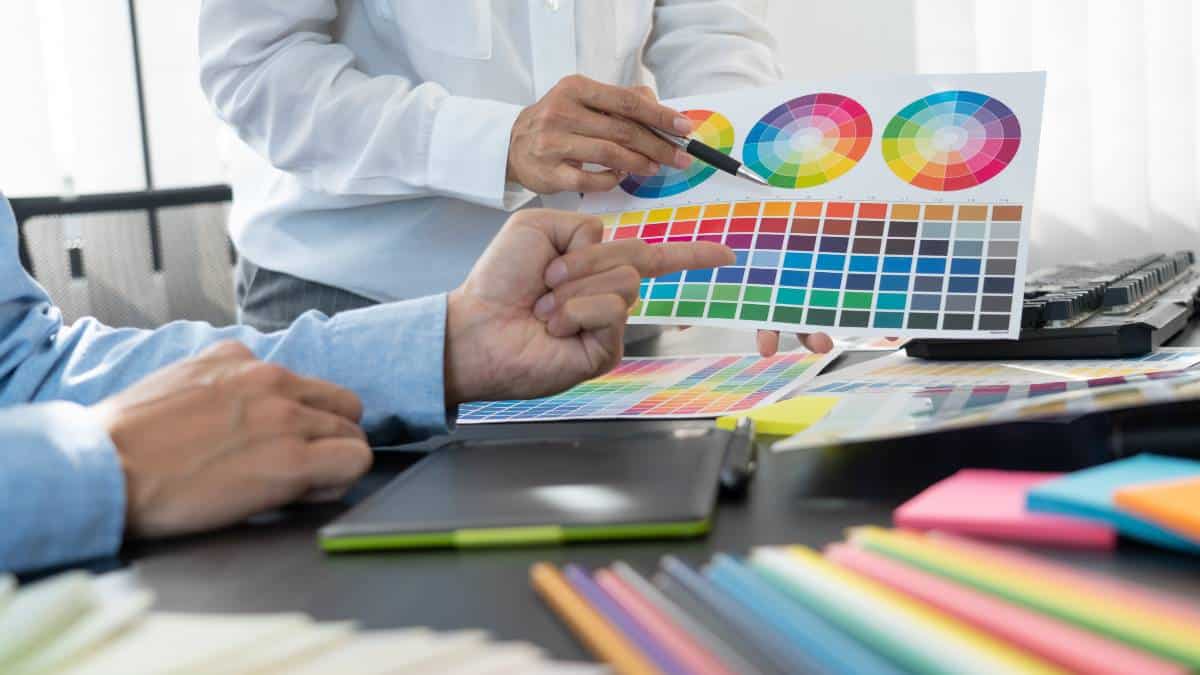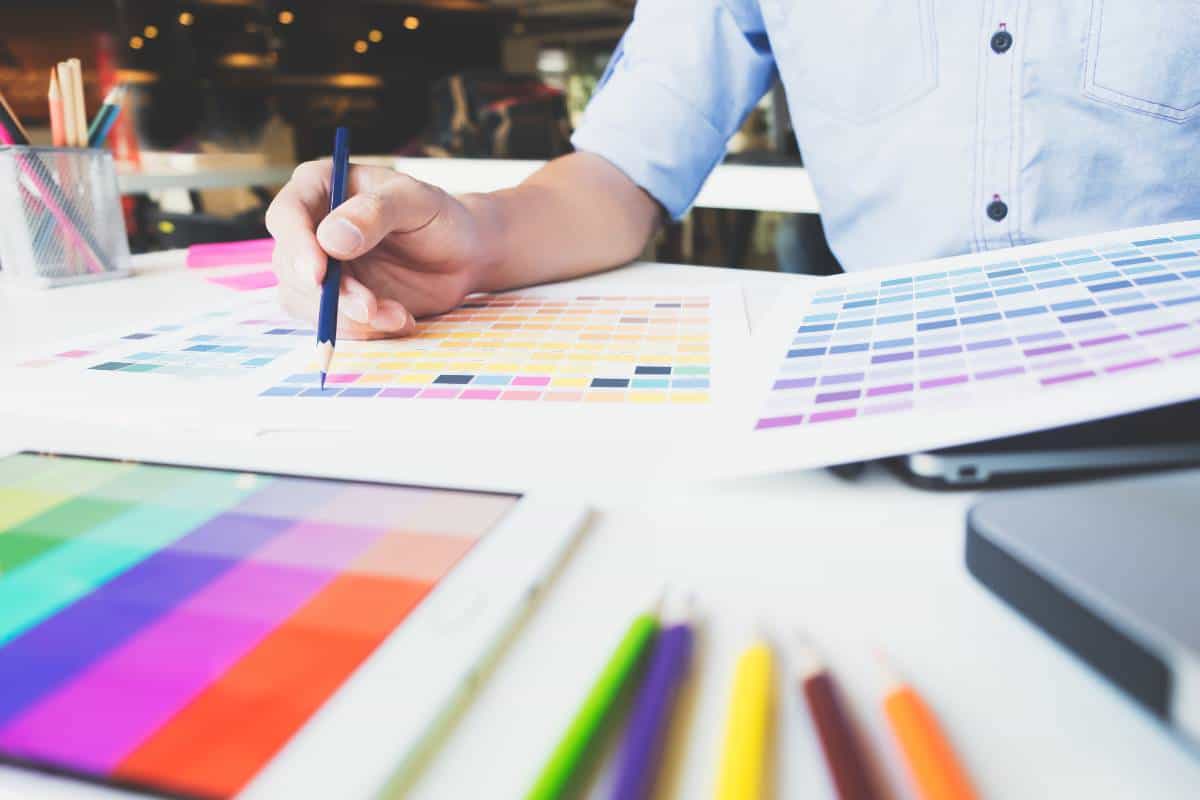Over 20+ years of spearheading digital marketing initiatives, one lesson has continued surfacing – thoughtful color selection massively impacts brand impressions and audience engagement.
As founder of Uplevel Digital, I’ve observed firsthand how “strategic color use forges memorable connections with target demographics by tapping into emotions.” Our data-driven approach pairs creative flair with conversion optimization for results.
In this article, we’ll explore actionable methods for identifying brand colors optimized for your business niche and audience, assembling aesthetically pleasing palettes that resonate psychologically, and continually refining color choice using sentiment feedback and metrics.
Key Takeaways
- Color choice is profoundly influential in shaping brand identity and recognition
- Research target demographics and industry norms to select optimal signature colors
- Consistent color palettes across assets like logos, sites, and ads crystallize perceptions
What is Color Psychology and How Does it Impact Branding?
Color psychology is truly fascinating when you dive into it. It’s the study of how different colors and color combinations unconsciously influence perceptions and behaviors in humans. Certain colors can spark certain emotions, capture attention, communicate ideas non-verbally, and shape first impressions.
Understanding the Basics of Color Psychology
Research has identified connections between colors and emotions. For example, blue is widely considered peaceful, professional, and trustworthy. It’s linked to feeling calm and clear-headed. Green represents naturalism, health, and tranquility. It’s mentally stabilizing and refreshing. Black signals luxury, modernism, and bold confidence. Yellow is playfully optimistic and captures attention easily (though can cause eye fatigue if overdone).
Colors also carry symbolic meanings in cultures that become ingrained over our lifetimes. White is purity in Western weddings and medicine, while associated with death in some Eastern cultures. Purple royalty and mysticism. Patterns form even though reactions are somewhat personalized based on nostalgic connections and individual taste too.
How Psychology of Color Influences Consumer Behavior
Hard data shows showing strategic color use sways product selection, brand loyalty, conversion rates, and even willingness to pay higher prices. One university experiment revealed test subjects chose the same chocolate in different colored wrappers – but had markedly more positive reviews of the “finest chocolate” wrapped in gold vs “Basic Chocolate” wrapped in white, despite identical contents!
Color is up to 85% of the reason people decide to purchase from a brand. Starbucks’s signature green elicits natural, invigorating associations – perfect for an energy-boosting morning coffee routine. Makeup giant Sephora uses feminine black packaging with pops of vibrant fuschia. Customers visiting Sephora expect a rich, indulgent, lively branding experience, and color plays a huge role in setting that expectation both online and in stores.
The Role of Color in Brand Perception
The colors strategically used in your brand identity and marketing have a psychological influence on how prospects perceive your company. Colors speak volumes about intangible traits and values when used thoughtfully and consistently. That’s why brand style guides dictate strict applications of precise Pantone shades.
Even industry giant Pepsi infamously faltered once from color deviation. In the 90s they unveiled a navy blue logo to compete with Coca-Cola’s classic red. But sales dropped due to brand identification dissolving without signature red and Pepsi soon after reverted to its red white and blue color scheme. Lesson learned!
How to Choose the Right Colors for Your Brand?
Choosing those make-or-break colors for your brand takes strategic consideration – but the impact is huge when done effectively. Where do you start translating abstract ideas about your company into visuals?
Factors to Consider When Selecting Brand Colors
Begin by identifying what emotions and ideas best represent your brand identity or personality. Do you want customers to feel joyful? Trusting? Intrigued? Empowered? Make a list, since colors sparking those feelings will resonate most.
Look at competitors too. Which colors are most frequently used in your industry? Can you take inspiration from category leaders? What specific color values or traits led them to choose those colors to communicate? Evaluate if aligning, contrasting, or adding unique flair makes sense.
Using Color Theory to Define Brand Identity
Don’t just randomly pick hues though! Well-defined color harmonies feel polished. Primary colors establish dominance but accent colors add flair. Adobe’s color wheel helps blend complementary or analogous combinations. And remember light colors stand out against dark ones. So fuschia text on black will pop more than black text on white. Use contrasts to guide where you want the eye to go.
Creating a Memorable Brand Color Palette
Once you’ve selected that stunning signature color it’s time to build out a full palette. Vary tints and shades of your key tone as accents across visual touchpoints. Want a richer, more premium vibe? Adagio Brown with golden halo orange accents resonates with sophistication. Feel breezy coastal vibes? Ocean blue base with tangerine starfish iconography pops. Build out enough flexibility for diverse applications while retaining consistency and recognizability.

Which Colors Work Best for Different Types of Brands?
While personal taste plays a role, some data-backed patterns exist between brand types and the most effective color choices psychologically. Let’s explore a few examples.
Psychological Associations of Different Colors
Common colors hold these connotations. Blue = trust, calmness, and reliability. Green = health, sustainability, tranquility. Purple = creative, mystical, sophisticated. Keep those baseline anchors in mind as we relate colors to brands.
Using Color Psychology to Establish Brand Personality
Soft pastel pinks help cosmetic brands channel feminine energy and self-care sentiments. Bright emerald greens allow financial planners to signal profitable decision-making guidance. Conservative blacks project law firms as pillars of unshakeable stability. Jewel-toned royal purple conveys refinement and intrigue for luxury hospitality brands wanting an exclusive, glamorous feel.
Purposefully matching colors to personality and emotional qualities transfers those impressions. Make your hue selections deliberately and strategically.
Implementing Color Variations for Brand Recognition
Look at the wildly successful fashion giant Louis Vuitton. They retained deep chocolate brown as a signature neutral for bags and boxes allowing famous monogram logos to truly captivate focus. But seasonal accessory releases shift accent colors from minty pastels to fused fuschias. It signals clients can indulge in playful whimsy through pops of color while relying on LV’s unwavering brown branded sophistication long term. Even sub-brands use creative color variations, however, like Off-White and multi-neon graffiti bags. This stimulates interest while harmonizing everything under LV fashion house leadership through that iconic brown.
How to Implement Color Psychology in Marketing Materials?
You’ve settled on the perfect shade of tranquil blue as your signature brand color and designed a stunning logo and business card set. But branding and marketing expand way beyond that. How do you take those initial color psychology principles and weave them into your overall presence?
Utilizing Colors in Logo Design for Brand Identity
Your logo is the cornerstone of recognition. Use signature colors consistently in iconography and stylized name treatments. But don’t be afraid to experiment with tints, outlines, shadows, and layering effects. Famous Starbucks shines white through green leaves. Perfect contrast punching through would get lost on white. Moz uses dimensional shadowing on red lettering, which injects bold energy and movement against clean background spacing.
Choosing the Most Effective Color Schemes for Marketing Collaterals
Stationary, advertisements, packaging, catalogs, brochures, even employee uniforms – every format should reinforce colors psychologically priming perceptions you outlined originally. Use style guides religiously. Pep up sober financial charts in brochures by making key data points bright success green. The airline in your fun vacation ads? Go vibrant and energetic. Same core color and adapted aesthetics.
Creating a Consistent Brand Image Through Color Usage
Persistent color conditioning across mediums cements retention and relationships via subconscious familiarity and positive associations. That’s why Coca-Cola red trucks match vending machines match Instagram graphics. Repeated exposure over time across contexts drills brand recognition and color meanings.
What Are the Common Mistakes to Avoid When Using Color Psychology in Branding?
Even seasoned marketers slip up at times when overly relying on personal color preferences or ignoring implications. What faux pauses require awareness?
Overlooking Cultural Color Symbolism in Global Branding
Remember white signals joy in the West but grief in the East. Assume blue soothes universally? Maybe not calming cultural interpretations exist too. Research goes a long way. When expanding internationally, consider regional color psychology norms.
Avoiding Clashing Color Combinations in Brand Visuals
Sometimes colors inherently clash dramatically. Green and red spark Christmas commercialism – probably not an ideal pairing for your accounting practice website! Have graphics looking disjointed? You may be hitting the visual dissonance of discordant color matches. Review principles around color harmonies if needing realignment.
Ignoring the Emotional Impact of Color Choices on Consumers
At the end of the day, branding color psychology significantly sways feelings and perceptions subconsciously constructed around your company. Lean into choices sparking connections suited to your brand identity. If transgender non-profit, consider gender-neutral purple over binary pink branding. Make choices deliberately aligned to ideals through stirring color science.
How to Evaluate the Success of Color Psychology in Branding Strategies?
You’ve put thoughtful research into signature colors and palettes psychologically primed to represent your brand identity. Launched beautifully consistent new visual assets across digital and print touchpoints for that unified brand experience. But now the pressing question – how well are your color psychology efforts resonating in the real world?
Measuring Brand Engagement Through Color-Related Campaigns
Add campaign tracking UTM parameters to links in new color-themed initiatives across marketing channels. Compare open rates, CTRs, and conversions against past email performance averages. Did that vibrant color overhaul of your monthly newsletter boost engagement? UTM data has the answers. Run paid advertisements on social media with your signature colors now integrated. Do click-through or conversion rates on those display differently than older generic collateral? Track performance by color-specific elements.
Analyzing Consumer Responses to Specific Color Initiatives
Leverage polls, surveys, and reviews to generate qualitative data on reactions beyond hard metrics alone. Ask customers directly about visual appeal, emotional impressions, brand differentiators, and color preferences in one-on-one interviews or focus groups. Probe their interpretations of new color-driven website layouts. What conveys strength? Playfulness? Is legibility an issue? Feedback subjective responses into design and strategy iterations.
Adapting Color Strategies Based on Marketing Performance Metrics
Let data and customer commentary guide your path forward. Overall brand sentiment is up but certain palette combinations tank with key segments. Adjust thoughtfully. Times change and color perceptions evolve across generations and cultures. Continual refinement using both psychological foundations and real-world testing keeps your color game nimble and effective through ever-shifting consumer tendencies.
Maybe industry disruptors embrace radically different palettes than category norms. Or previously reliable accent colors now read as dated. Lean into Agile frameworks by assessing granular and holistic metrics then responding, improving, and enhancing branding colors fueling performance KPIs.
Harnessing Color Psychology to Reinforce Branding
Demystifying Color Psychology in Marketing
Before applying color psychology to branding, clarifying what exactly color psychology encompasses helps set the stage.
At its core, color psychology examines how color exposure unconsciously affects human perceptions, attitudes, and behaviors. Responses arise through a blend of biological reactions, cultural conditioning, and personal nostalgia.
While influences vary across age, gender, ethnicity, and other factors, some consistent patterns emerge:
- Blue instills trust and tranquility
- Green promotes nature and wellness
- Red symbolizes excitement and intensity
- Yellow boosts optimism and clarity
A few real-world statistics illustrate the business impact:
- 92% of shoppers place color as a primary factor when buying products
- Branding with preferred colors enjoys 23% higher brand recognition
- Changing a call-to-action button color can increase clicks by over 35%
Color selection in branding and marketing carries tremendous influence!

Pinpointing Your Brand Identity and Audience
To choose optimized colors, first clarify your organization’s:
- Core ethos – What emotions should your brand elicit? What principles and personality traits define you?
- Customer targets – What market segments are you pursuing? What do you know about their color preferences?
Uplevel Digital aims to fuse data-driven precision with human-centric empathy. We admire innovative disruption but value sustainability. Our clients typically include:
- Established SMBs – Seeking expanded reach by embracing digital
- Startup visionaries – Committed to scalable foundations
- Non-profits – Restricted budgets requiring efficacy
These insights spot helpful creative directions to explore.
Selecting Your Signature Brand Colors
With audience and brand identity pillars clarified, researching common color associations in your niche and prospects’ tendencies can crystallize smart color ideas.
Industry Color Norms and Competitor Analysis
Explore what colors frequent your field by glancing at competitors, icons, statistics graphics, and related elements.
If Emerald dominates financial consulting site logos, that hue likely resonates by signaling growth and prosperity. Faded black on beige repeatedly surfaces among law firms connoting dependable professionalism.
Uplevel Digital’s combinations of vibrant red, cool greys, and deep blue mirrors big tech brands, aligning with innovation and authority.
Consumer Research on Age, Gender and Occupation
Demographic influences on color preferences reveal useful insights too. While patterns exist, retain flexibility knowing individuation matters.
Women generally find purple hues more appealing, but plenty still identify azure blue as their favorite. Tech CEOs leaning on black and red may seem unapproachable to some segments.
Balance broad targeting with personalization as you expand reach.
Emotional Messaging and Values-Driven Choice
Finally, anchor back on core identity drivers established at the beginning when deciding on colors.
What feelings should your brand spark? If affordable exuberance is key, playful oranges may align better than staid navies. Does ecological stewardship form a key tenet? Earthy greens and sky blue wonderfully convey sustainability.
For Uplevel Digital, rich red symbolized our bold innovative spirit, cooled by steadfast steel grey and deep blue conveying insightful expertise.
Curating Harmonious and Impactful Color Palettes
With one or more anchor colors selected, graphic designers blend, test, and refine to craft balanced, aesthetically pleasing palettes.
Creative Development Informed By Color Theory
Expert digital artists adhere to time-tested principles, including:
- 60-30-10 – Dominant color 60%, secondary 30%, accent 10%
- Color Harmony – Complementary, analogous, and triadic combinations
- Accessibility – Sufficient contrast for those with vision deficiencies
Style Guide Documentation
Solidifying specific HEX codes and use cases in a style guide ensures hues remain consistent across teams, preserving recognition.
For Uplevel Digital’s recent rebrand, we outlined:
- Primary Red #DA291C – Logo, headers, call-to-action buttons
- Secondary Blue #002060 – Footer background, text headers
- Accent Grey #E7E7E8 – Page background, divider lines
Testing Response and Refining Iteratively
We continually experiment with tints, shadows, and accent colors using multivariate testing on-site assets to optimize engagement and conversions.
Applying Color Psychology Across Marketing and Branding Touchpoints
With palettes locked in, seamlessly integrating colors across touchpoints builds connections through repetitive exposure while allowing tailored artistry.
Website Design Considerations
Beyond expected logo integration, website hero images establish signature colors through vibrant photography and graphics alongside boldly colored clickable menus and calls-to-action.
Content sections retain black text for readability but feature color-coded topic headers and divider lines. Palm tones prompt tropical imaginings on travel articles while vibrant red introduces thought leadership editorials.
Key Takeaways
- Psychologically informed color choice shapes brand identity, recognition, and relationship-building
- Know core brand ethos and audience preferences, then artfully translate them into stirring palettes
- Consistent application across touchpoints like sites, ads, and product packaging cements connections
- Continual optimization guided by sentiment feedback, engagement data, and conversion metrics
FAQs
How often should brand colors be updated?
Major overhauls are generally tied to logo redesigns every 2-5 years. Tweaking secondary hues can refresh annually. Evolving color meanings and demographic preferences should inform but not dictate changes.
What tools help create or test color palettes?
Adobe Color CC and Coolors let you develop color schemes adhering to harmony principles. Google Optimize, CrazyEgg, and Clicktale facilitate multivariate testing of website assets with color variations. Qualitative feedback is key too though!
How do I make color palettes accessible?
Ensure sufficient contrast between background and text colors by meeting Web Content Accessibility Guidelines (WCAG) 2.1 standards. Tools like Contrast Checker assess compliance. Desaturating brighter hues and adding bold outlines to elements also assists.
Should my brand use more than one accent color?
Limiting to one accent color creates the strongest consistency recognition tying disparate assets together. However, occasionally utilizing secondary accent hues sparingly can help differentiate product lines or campaign themes. Just ensure dominant branding color remains chief.
Why do some industries use similar colors?
Research suggests brand color innovation can boost memorability, yet many organizations prefer complementing competitors through color norms signaling collectively valued traits to their niche target consumers. Often an industry-leading pioneer sets expectations.
Can color affect consumer behavior in marketing?
Yes, color can significantly impact consumer behavior in marketing by influencing perceptions, emotions, and purchase decisions. It is essential to choose colors that align with your brand’s message and appeal to your target audience.
How can I use color psychology to evoke specific emotions in consumers?
By understanding the psychological associations of different colors, you can strategically use them in your branding and marketing materials to evoke specific emotions and responses in consumers, ultimately guiding their perceptions and actions.
Conclusion
Strategic color psychology application in branding, when informed by research into emotive associations, audience leanings, and industry tropes, can profoundly shape positive brand perceptions and engagement.
If you have questions on identifying your ideal signature color palette or wish assistance concept testing proposed color designs, Uplevel Digital offers complimentary color consulting sessions. Our team eagerly helps craft human-centric color psychology in marketing solutions optimized for your organization’s unique identity and goals.






